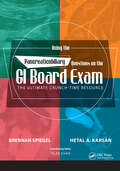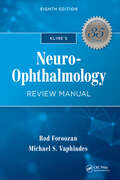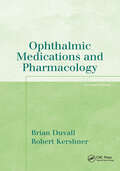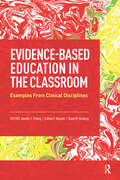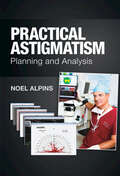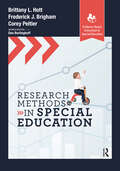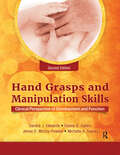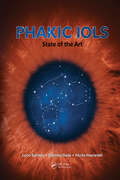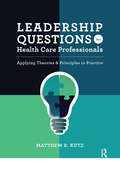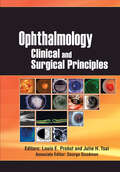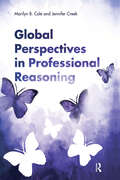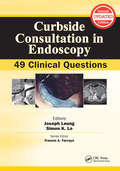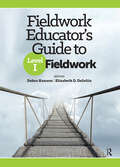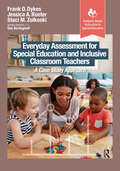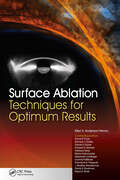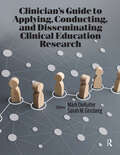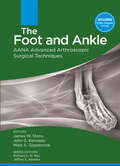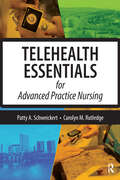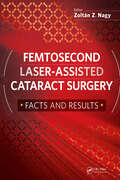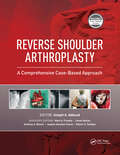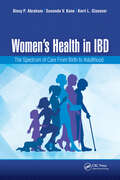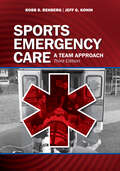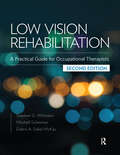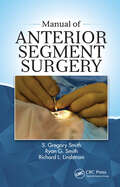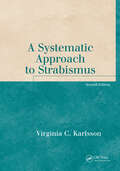- Table View
- List View
Acing the Pancreaticobiliary Questions on the GI Board Exam: The Ultimate Crunch-Time Resource
by Brennan Spiegel Hetal KarsanThe Pancreas. It’s not very large, but it packs a punch. You gotta know about the pancreas. Then toss in the crazy complexities of the biliary system and there’s is a lot to learn to manage your patients. In this latest book in the Acing GI Board Exam Series, the focus is on the pancreas and biliary tree and how they can cause trouble. In today’s fast-paced world, it is a struggle to keep up with the burgeoning panc-bil literature. Until now, there has been no single, slim, but high-yield volume that summarizes the panc-bil you really need to know for the board exam. This review book keeps you on your toes and sharp for everyday clinical practice too. What is the best way to effectively prepare and study, if reading multiple resources can’t seem to fit into your daily schedule? The answer to your study questions (and study time!) can be found inside Acing the Pancreaticobiliary Questions on the GI Board Exam: The Ultimate Crunch-Time Resource. Dr. Brennan MR Spiegel and Dr. Hetal A. Karsan have collected every pearl of wisdom, high-yield factlet, panc-bil "board buzzword," and classic imaging study they could muster, all while keeping Acing thePancreaticobiliary Questions on the GI Board Exam a manageable size. Why You Will Need to Read Acing the Pancreaticobiliary Questions on the GI Board Exam: Carefully vetted board-style clinical vignettes with color images Comprehensive yet succinct answers using a high-yield format Emphasis on key clinical pearls and “board buzzwords” Answers to classic board “threshold values” questions that you need to know but always seem to forget Rapid-fire, crunch-time exam with 150 classic one-liners Acing thePancreaticobiliary Questions on the GI Board Exam fills the unmet need in board review by presenting time-tested and high-yield information in a rational, useful, and contextually appropriate format suitable studying for the board exams and preparing for the recertification exam. Chapters Include: A compilation of general lessons learned from past test-takers “Tough Stuff” board review vignettes Board review “Clinical Threshold Values” “Crunch-Time” Self-Test and Answer Guide—time to get your game on! With its focus on pearl after pearl, emphasis on images, and attention to high-yield “tough stuff” vignettes you don’t know the answers to (yet), Acing the Pancreaticobiliary Questions on the GI Board Exam is truly the ultimate crunch-time resource for acing the GI board examination, taking recertifying examinations, looking good on clerkship rounds, or for just challenging yourself with interesting and entertaining vignettes.
Kline's Neuro-Ophthalmology Review Manual
by Rod Foroozan Michael VaphiadesFor over 35 years, Kline’s Neuro-Ophthalmology Review Manual has presented a unique and user-friendly approach to address clinical neuro-ophthalmology principles used in everyday practice. This Eighth Edition continues that tradition, providing a timely update, while also maintaining the same user-friendly and concise format. Dr. Rod Foroozan and Dr. Michael Vaphiades have taken the mantle of updating this respected manual from Dr. Lanning Kline and continue his tradition of a simple summary of the most important clinical aspects of neuro-ophthalmology with schematic illustrations and material relevant to everyday practice. They are joined by their contributing authors, all seasoned neuro-ophthalmologists, and have organized the book to provide the essential key information on neuro-ophthalmic disorders. The Eighth Edition provides a comprehensive update to the latest information, adds many new effective exercises for case study, and is a complete update on neuro-ophthalmic conditions, including results of recent clinical trials and emerging literature. Also new is the inclusion of a table of neuro-ophthalmic emergencies which serves as a quick guide so that these potentially life-threatening and blinding conditions can be accessed easily.Chapters include: Nystagmus and Related Ocular Oscillations Myasthenia and Ocular Myopathies Nonorganic Visual Disorders Disorders of Higher Visual Function Neuroimaging Kline’s Neuro-Ophthalmology Review Manual, Eighth Edition has all the fundamentals presented logically for all practitioners and residents in ophthalmology, neurology, and neurosurgery. A popular choice among colleagues for more than 35 years, this a must-have resource in neuro-ophthalmology.
Ophthalmic Medications and Pharmacology (The Basic Bookshelf for Eyecare Professionals)
by Brian Duvall Robert M. KershnerFor those who are new to the subject, ocular pharmacology can be a difficult and sometimes overwhelming topic. Ophthalmic Medications and Pharmacology, Second Edition is a reader-friendly guide that provides a quick review and basic clinical reference of ocular pharmacology.In this updated and revised second edition, Drs. Duvall and Kershner present an overview to the medication and drugs found most commonly in ophthalmic practice without overwhelming those professionals new to the subject. Ophthalmic Medications and Pharmacology concisely reviews commonly used and prescribed medications, how they work, dosage, therapeutic use, and potential side effects. This new edition also highlights key information for patients about the medications they encounter and are prescribed in the clinic.Ophthalmic staff, students, and research professionals looking for an introduction and basic go-to guide will welcome having a copy of Ophthalmic Medications and Pharmacology by their side.New to this edition:· An appendix focused on the drug approval process.· A chapter on retinal therapies.· Study icons to assist in the learning process.· New coverage of vasoconstrictors.
Evidence-Based Education in the Classroom: Examples From Clinical Disciplines
by Jennifer Friberg Colleen Visconti Sarah GinsbergEvidence-Based Education in the Classroom: Examples From Clinical Disciplines shows educators how to use evidence to inform teaching practices and improve educational outcomes for students in clinically based fields of study.Editors and speech-language pathologists Drs. Jennifer C. Friberg, Colleen F. Visconti, and Sarah M. Ginsberg collaborated with a team of more than 65 expert contributors to share examples of how they have used evidence to inform their course design and delivery. Each chapter is set up as a case study that includes: A description of the teaching/learning context focused on in the chapter A brief review of original data or extant literature being applied A description of how evidence was applied in the teaching/learning context Additional ideas for how evidence could be applied in other teaching/learning contexts across clinical disciplines Additional resources related to the pedagogy described in the case study (e.g., journal articles, books, blogs, websites) Educators in the fields of speech-language pathology, audiology, nursing, social work, sports medicine, medicine, dietetics, dental assisting, physician assisting, radiology technology, psychology, and kinesiology—already familiar with evidence-based practice—will find this resource helpful in implementing evidence-informed approaches to their teaching.While the content in clinical programs is quite different, there are many similarities in how to teach students across such programs. Evidence-Based Education in the Classroom: Examples From Clinical Disciplines highlights these similarities and represents a masterclass in how to practice evidence-based education.
Practical Astigmatism: Planning and Analysis
by Noel AlpinsThe surgical correction of astigmatism is the last frontier to optimizing visual outcomes for patients. Practical Astigmatism: Planning and Analysis is a comprehensive guide to correcting astigmatism from pre-operative planning to post-operative analysis. This provides readers with unique insight to what actually happened surgically: did the astigmatism over or under correct? Was it on-axis or off-axis? With this book, ophthalmologists will be able to analyze previous procedures with the appropriate nomograms and more often achieve targeted outcomes. Dr. Noel Alpins has developed the Alpins Method of astigmatism to provide accurate planning and analysis of astigmatism procedures. His method focuses on analyzing refractive and corneal astigmatism parameters and using the results in future surgery to improve visual outcomes. The importance of the ocular residual astigmatism (ORA) is detailed when planning astigmatism surgery.Practical Astigmatism features vector planning for refractive laser surgery as well as planning and analysis applied to cataract and limbal relaxing incisions, , in addition to demonstrating graphical analysis of astigmatism using high quality vector and fan diagrams, as used in scientific journals. In addition, hemidivisional analysis of the irregular cornea, corneal coupling in incisional and excimer laser surgery for mixed astigmatism and toric IOL planning with total corneal power using corneal topographic astigmatism (CorT total) are addressed as well.Some Questions Answered Inside: What is the difference between regular and irregular astigmatism? How do I diagnose each, and how does this affect my surgical technique? Can I incorporate corneal astigmatism when performing excimer laser surgery? Why are my LRIs undercorrecting the astigmatism? Is it safe to perform excimer laser on keratoconous patients? Which corneal astigmatism measure do I choose and what do I do following a refractive surprise? Practical Astigmatism: Planning and Analysis will help ophthalmologists, optometrists, and technicians alike address each patient’s unique circumstances and act as your in-depth guide to correcting astigmatism.Testimonials… “For more than three decades I have been listening to, arguing with, and admiring the work of Dr. Noel Alpins in the field of astigmatism. Despite his remote location on the small island of Australia, his knowledge of astigmatism is at the peak of Mt. Everest. There are few others who have devoted their careers to understanding and managing astigmatism for which the world of ophthalmology is truly grateful.” - Robert H. Osher, MD “Noel is an original thinker who took on and conquered the complexities of astigmatism analysis, publishing the seminal papers on the way. His work has formed the cornerstone from which our current understanding and management of astigmatism has been built. He is someone from whom we have all learnt a great deal and this book is a testament to this.” - Dan Z Reinstein, MD MA(Cantab) FRCSC DABO FRCOphth FEBO
Research Methods in Special Education (Evidence-Based Instruction in Special Education)
by Brittany Hott Frederick Brigham Corey PeltierResearch Methods in Special Education equips readers with the knowledge needed to make a difference with data. Authors Drs. Brittany L. Hott, Frederick J. Brigham, and Corey Peltier provide access to cutting edge methodologies and related skills researchers need to successfully carry out projects in applied settings. Dedicated chapters focusing on quantitative research synthesis (e.g., meta-analysis, meta-synthesis), single case design, and program evaluation methods allow readers deeply invested in the field of special education to develop a firm foundation, enabling them to ask and answer their socially significant research questions.Written for students in special education teacher prep programs, early career faculty, school administrators, and curriculum specialists, this text includes numerous features that set it apart from other available resources: Dedicated chapters on ethics, establishing effective research partnerships, and evidence-based practice Cutting-edge program evaluation methods and reporting Comprehensive coverage of methods commonly used in special education Detailed information on securing special education funding Case studies, exemplars, resources, and recommendations for additional reading Included with the text are online supplemental materials for faculty use in the classroom. YouTube videos featuring interviews with authors The up-to-date research practices in this text are a valuable addition for educators and researchers serving students with disabilities who have a responsibility to support in-school and post-school outcomes. Research Methods in Special Education gives educators the tools to facilitate a deeper understanding of the research process and evidence-based practice.
Hand Grasps and Manipulation Skills: Clinical Perspective of Development and Function
by Sandra J. Edwards Jenna D. McCoy-Powlen Donna Gallen Michelle A. SuarezHand Grasps and Manipulation Skills: Clinical Perspective of Development and Function, Second Edition is an expertly designed and logically organized text that provides an accurate and clear depiction of the development of hand grasps and the taxonomy of functional hand grasp.Hand Grasps and Manipulation Skills, Second Edition by Sandra J. Edwards, Donna B. Gallen, Jenna D. McCoy-Powlen, and Michelle A. Suarez is full of concise and user-friendly text that is written to assist in understanding complex information. The photographs, illustrations and charts have been expanded in this Second Edition and present new content areas for students and clinicians to use in education and practice.Hand Grasps and Manipulation Skills, Second Edition is unique in that it is also the only text on the market that contains this comprehensive pictorial information about hands and their grasps. Additional unique features include rare information about in utero development of the hand, left handedness, scissor skill development, in hand manipulation skills, and extensive information regarding clinical application. Hand Grasps and Manipulation Skills, Second Edition is a text that can be used as a career long reference. It provides all the pertinent and comprehensive information for students to learn about the development of the hand in one place, and is expertly and thoroughly referenced with the latest research.Hand Grasps and Manipulation Skills: Clinical Perspective of Development and Function, Second Edition provides clear information on a very specific subject, which makes it the ideal reference for occupational therapy professors, students and clinicians; mechanical engineers, computer software instructors, and engineers working in robotics; medical students and orthopedic hand surgeons.
Phakic IOLs: State of the Art
by Lucio Buratto Stephen Slade Nicola HauraniehThe surgical correction of refractive vision errors has dramatically and continually changed over time. The evolution of laser vision correction has been aided by advancements in the technology, growing experience, and improved understanding of the eye and its response to surgery. However, not all refractive errors can be treated with the laser. Phakic IOLs: State of the Art is designed to provide the advances in phakic IOL technology and techniques, ideal for physicians who treat many of the patients who are not candidates for laser vision correction. The collaboration of Dr. Lucio Buratto, Dr. Stephen G. Slade, and Dr. Nicola D. Hauranieh, along with a team of international surgeons, has produced a complete book specifically aimed to improve the treatment and therefore the quality of vision of patients. Phakic IOLs: State of the Art is designed for ophthalmologists interested in learning the concepts, developing the skills, and preparing for phakic IOL procedures. This book contains a detailed description of the basic technique of the operations, as well as the special techniques devised by the international contributors. Richly illustrated with over 200 images that demonstrate the various concepts, readers are able to develop a more thorough understanding of phakic IOL implantation. This definitive resource couples both the authors’ and contributors’ diverse experience and knowledge to produce a complete resource of vision correction with phakic IOLs.Expert ophthalmologists interested in being on the cutting edge and enhancing their surgical skills, as well as new physicians, will benefit from adding Phakic IOLs: State of the Art to their personal library.
Leadership Questions for Health Care Professionals: Applying Theories and Principles to Practice
by Matthew KutzLeadership Questions for Health Care Professionals: Applying Theories and Principles to Practice by Dr. Matthew R. Kutz presents some of the most common leadership questions with the intent to facilitate intrigue and dialogue about the general concept of leadership and an awareness of potential leadership issues facing health care professionals.Leadership Questions for Health Care Professionals presents responses that will initiate discussion, as well as offer solutions based on the best available evidence across a wide spectrum of relevant research. Discussion questions at the end of each response will allow the reader to engage in critical thinking and re-evaluate their experiences and offer new insights into their leadership journey.Sections include questions on key issues for health care professionals: The essence of leadership Leadership development Teamwork and communication Change Organizational culture and complexity Leadership ethics and power Diversity and multicultural leadership Leadership Questions for Health Care Professionals takes an interprofessional and interdisciplinary approach and is relevant for athletic trainers, physical therapists, occupational therapists, speech-language pathologists, nurses, physicians, and more.Leadership Questions for Health Care Professionals: Applying Theories and Principles to Practice offers students a broader conceptual understanding of leadership, as well as the depth required by seasoned health care clinicians, managers, and executives who are looking for practical and evidence-based insights to their toughest leadership issues.
Ophthalmology: Clinical and Surgical Principles
by Louis Probst Julie TsaiOphthalmology: Clinical and Surgical Principles is a comprehensive, yet, accessible guide to medical and surgical ophthalmology that succinctly addresses the diagnosis and treatment of all major diseases of the eye. Louis E. Probst, Julie H. Tsai, and George Goodman, along with the 16 world expert subspecialty contributors, have organized the concise, clinically focused, and user-friendly chapters by subspecialty and include the indications, techniques, and complications of common ophthalmic surgical procedures. This attentive chapter organization reflects the way modern-day ophthalmology is practiced.Ophthalmology: Clinical and Surgical Principles delivers practical emphasis, allowing the reader to apply the information into a clinical setting. Residents will additionally benefit from the surgical options discussed for specific disorders. Features:• More than 400 high-quality diagrams, figures, and color photographs.• Diagrams, tables, and figures to facilitate comparisons and assimilation of the information.• References to provide a starting point for further study and research.• Study questions at the conclusion of each chapter to allow readers to test their knowledge and prepare for important examinations.Ophthalmology: Clinical and Surgical Principles is comprehensive and practical enough to be a complete resource for the ophthalmologist, ophthalmology resident, optometrist, as well as family physicians, medical students, and ophthalmic technician.
Global Perspectives in Professional Reasoning
by Jennifer Creek Marilyn B. ColeGlobal Perspectives in Professional Reasoning is the first text of its kind to address the broader scope of occupational therapy practice and the different types of professional reasoning that can be employed, including strategic, political, nonlinear, creative, and social reasoning. This text encompasses a wide range of thinking skills and cognitive processes used by occupational therapists, from reflecting on practice to solving problems, and from reasoning in the clinic to reasoning in the wider political, social, and cultural worlds.Marilyn B. Cole and Jennifer Creek and their contributors are therapists, educators, and scholars who have explored new areas of professional practice and written about the thought processes that reinforced their actions. The authors come from around the world, providing a global perspective while also demonstrating that occupational therapists within different cultures serve remarkably similar human needs: to be included in their communities, to have occupational choices, and to determine their own life course.Many of the contributors in Global Perspectives in Professional Reasoning have identified and analyzed their own thought processes as they tackled complex and challenging tasks, often in unfamiliar contexts. These challenging tasks have produced several entirely original conceptualizations of professional reasoning, such as development and spiritual reasoning. The contributors start by observing what is going on, try to make sense of the situation, and then work out what to do. Other contributors are fascinated by a theory, a policy, or an approach; study it; and then look for ways to utilize it in practice. Most of the time, contributors focus their attention on the process of reasoning rather than on the specific types of reasoning they are employing or on desired outcomes.Inside Global Perspectives in Professional Reasoning, each chapter charts the learning process that contributors went through as they extended their thinking skills and processes to meet the challenges they encountered. All the chapters describe reasoning in practice and all of them utilize theory. A broad and fresh take on professional reasoning in occupational therapy practice, Global Perspectives in Professional Reasoning is the perfect resource for occupational therapy students and clinicians who want to utilize reasoning to tackle the most complex and challenging of tasks.
Curbside Consultation in Endoscopy: 49 Clinical Questions (Curbside Consultation in Gastroenterology)
by Joseph Leung Simon K. LoCurbside Consultation in Endoscopy: 49 Clinical Questions has been updated into a Second Edition! The Second Edition contains new questions and is completely updated!Curbside Consultation in Endoscopy: 49 Clinical Questions, Second Edition contains new questions and brief, practical, and evidence-based answers to the most frequently asked questions that are posed during a “curbside consultation” between surgical colleagues. Dr. Joseph Leung and Dr. Simon Lo have designed this unique reference, which offers expert advice, preferences, and opinions on tough clinical questions and situations commonly encountered in endoscopy. The unique Q&A format provides quick access to current information related to therapeutic endoscopy with the simplicity of a conversation between two colleagues. Illustrative images, diagrams, and references are included to enhance the understanding of endoscopy.Some of the questions that are answered:• What Do People Do for the Treatment of Achalasia These Days? Does it Matter if the Symptoms Are Severe or if the Patient Is Elderly?• I Had a Difficult Colonoscopy and No Matter What I Tried, I Just Could Not Reach the Cecum. I Maxed Out on IV Sedations and Have No Anesthesiology Support. Can You Help Me?• A 45-Year-Old Patient With Known Hepatitis C Was Admitted Because of Massive Upper GI Bleeding. What Should I Do?• A 55-Year-Old Veteran Had a Ruptured Gallbladder and a Difficult Cholecystectomy. Postoperatively, the Patient Had Persistent Bile Leakage Despite Months of Multiple Biliary Stenting. What Can I Do?• How Do We Manage a Patient With a 10-cm Pseudocyst Who Is Currently Asymptomatic• What Is a Reliable Method to Estimate the Location of a Lesion Found on Capsule Endoscopy?Curbside Consultation in Endoscopy: 49 Clinical Questions, Second Edition provides information basic enough for residents while also incorporating expert advice that even high-volume clinicians will appreciate. Gastroenterologists, fellows and residents in training, surgical attendings, and surgical residents will all benefit from the user-friendly and casual format and the expert advice contained within.
Fieldwork Educator’s Guide to Level I Fieldwork
by Debra Hanson Elizabeth DeIuliisA new resource for occupational therapy academic fieldwork coordinators and fieldwork educators, Fieldwork Educator’s Guide to Level I Fieldwork is a practical guide for faculty and clinicians to design and implement Level I fieldwork experiences for occupational therapy and occupational therapy assistant students.Fieldwork Educator’s Guide to Level I Fieldwork was designed to address the challenges of integrating Level I fieldwork with classroom learning experiences. Expansive and versatile, the book meets the recently expanded definition of Level I fieldwork according to the 2018 Accreditation Council for Occupational Therapy Education standards, including faculty-led experiences, standardized patients, simulation, and supervision by a fieldwork educator in a practice environment.Each unit of the text builds upon the previous unit. The first unit provides fundamental knowledge on experiential learning and includes an orientation to the purpose of Level I fieldwork in occupational therapy. Building on this foundation, the second unit equips the reader with resources to develop a Level I fieldwork learning plan suitable for their setting. The final units focus on situational scenarios that emerge during Level I fieldwork placements and provides a framework for assessing student learning during Level I fieldwork. While each chapter is designed to build upon one another, they also can be used as stand-alone resources depending on the needs of the reader.What is included in Fieldwork Educator’s Guide to Level I Fieldwork: Up-to-date terminology Experiential learning frameworks and models in diverse contexts, including role emerging and simulation Strategies for addressing anxiety and student stress management and supporting students with disabilities Models to support clinical reasoning development during Level I fieldwork Mechanisms to foster student professional development and communication skills Be sure to also look into the successive textbook, Fieldwork Educator’s Guide to Level II Fieldwork, which was designed in-tandem with this book to be a progressive resource that exclusively focuses on Level II fieldwork.
Everyday Assessment for Special Education and Inclusive Classroom Teachers: A Case Study Approach (Evidence-Based Instruction in Special Education)
by Frank Dykes Jessica Rueter Staci ZolkoskiEveryday Assessment for Special Education and Inclusive Classroom Teachers: A Case Study Approach provides a foundation in practical research-based methods to help today’s teachers tailor their instruction to meet the needs of all learners.With an easy-to-understand format, Everyday Assessment for Special Education and Inclusive Classroom Teachers combines real-life case studies with practitioner-friendly wording to teach and describe assessment topics in a concise manner. Practical applications for use in classroom settings can also be found throughout the text.What’s included in Everyday Assessment for Special Education and Inclusive Classroom Teachers: Example progress monitoring charts Curriculum-based assessments, behavior charts, and norm-referenced assessments to guide the reader when extracting data and inform everyday teaching practices Activities to practice skills and self-reflect on learning objectives at the end of each chapter Everyday Assessment for Special Education and Inclusive Classroom Teachers: A Case Study Approach pairs rationale and research with real-life case studies and applications for practice to prepare pre-service teachers to meet the unique needs of every learner.
Surface Ablation: Techniques for Optimum Results
by Ellen PennoWith Surface Ablation: Techniques for Optimum Results, refractive surgeons will learn efficient pre- and post-op routines that optimize chair time and lead to improved safety and excellent results for patients. Inside Surface Ablation: Techniques for Optimum Results by Dr. Ellen Anderson Penno is joined by 9 contributors who offer a practical approach with clinically useful tips including patient counseling and post-operative care that will improve patient satisfaction. This up-to-date book is an excellent resource for patient assessment of candidacy for refractive surgery or in post-operative co-management. In addition to chapters with information on patient selection, surgical techniques, post-op care, and prevention and management of complications, Surface Ablation: Techniques for Optimum Results includes several articles, contributed by leaders in the refractive surgery field, covering a variety of topics including surface ablation in keratoconus patients, corneal cross-linking, and ectasia. Surface Ablation: Techniques for Optimum Results is a clinically-oriented resource for residents and new refractive surgeons as well as the many seasoned refractive surgeons, general ophthalmologists following the increasing trend of transitioning away from LASIK towards surface ablation for many of their patients.
Clinician’s Guide to Applying, Conducting, and Disseminating Clinical Education Research
by Mark DeRuiter Sarah GinsbergClinician's Guide to Applying, Conducting, and Disseminating Clinical Education Research provides clinical educators with the fundamental knowledge to be effective consumers of research and integrate it into their clinical education practice.Clinical educators are routinely called upon to provide early-career clinicians with clinical education and supervision within their practice. Clinician’s Guide to Applying, Conducting, and Disseminating Clinical Education Research fits at the intersection of clinical education and research for the supervising clinician—helping clinicians consider how they might contribute to the scholarship of teaching and learning related to clinical education.This one-of-a-kind text features a multidisciplinary perspective with contributors from various fields in allied health, such as speech-language pathology, occupational therapy, audiology, physical therapy, and more.What’s included in Clinician’s Guide to Applying, Conducting, and Disseminating Clinical Education Research: A hands-on workbook section for clinical educators to apply the content to education and clinical supervision research Chapters on seeking research mentorship, qualitative and quantitative research foundational concepts, and publishing and presenting research Parallels between evidence-based practice and evidence-based education Clinician’s Guide to Applying, Conducting, and Disseminating Clinical Education Research walks the reader through generating research all the way to implementation and dissemination while linking communities of working professionals to their students and research institutions.
The Foot and Ankle: AANA Advanced Arthroscopic Surgical Techniques (AANA Advanced Arthroscopic Techniques series)
by James Stone Mark Glazebrook Kennedy JohnCo-published with the Arthroscopy Association of North America, The Foot and Ankle: AANA Advanced Arthroscopic Surgical Techniques is a comprehensive technique-based book that presents the latest diagnostic and reconstructive techniques in arthroscopic surgery for the foot and ankle. The Foot and Ankle: AANA Advanced Arthroscopic Surgical Techniques is authored by premier arthroscopic surgeons Drs. James W. Stone, John G. Kennedy, and Mark Glazebook, and their international list of expert contributors. This comprehensive resource includes preferred physical examination testing and diagnostic imaging choices in pre-operative planning and patient selection, state-of-the-art step-by-step description of the procedures, detailed surgical equipment lists to perform each procedure, clear and precise indications for surgery and the thoughtful rationale behind stated contraindications, controversial indications, post-operative protocols, and potential complications. The written text is supported by numerous color images and a website with invaluable, narrated video clips depicting disease-specific arthroscopic techniques specific to the foot and ankle. Features inside The Foot and Ankle: AANA Advanced Arthroscopic Surgical Techniques Narrated video accompanies all surgical techniques, focusing on the stepwise approach to each operation Consistent organization throughout the book results in a bulleted and user-friendly interface for a quick reference or prolonged study Top 5 Technical Pearls for each procedure to enhance outcomes and to avoid common pitfalls and complications High-quality artwork and figures to compliment clinical images Equipment and surgical technique checklists for quick reference prior to surgery Each expert contributor was chosen for his or her expertise for a specific topic related to The Foot and Ankle, so the reader benefits by the highest quality and treatment recommendations to provide state-of-the-art care to his or her patient.Some chapter topics include:-Reconstruction Using Allograft and Autograft-Lateral Approach to Subtalar Arthroscopy-Achilles Tendinopathy-Chondral Defects of the First MTP Joint-Matrix-Induced Autologous Chondrocyte Implantation
Telehealth Essentials for Advanced Practice Nursing
by Patricia Schweickert Carolyn RutledgeA timely, practical, and concise resource for advanced practice registered nursing (APRN) students, faculty, and providers, Telehealth Essentials for Advanced Practice Nursing provides readers with an understanding of and tools to embrace the emerging field of telehealth and optimize its application in clinical practice. Telehealth offers a unique solution to many health-care challenges, such as provider shortages, chronic disease management, an aging population, protection from infectious disease, and limited access to care. As telehealth is being incorporated into health care and health care delivery at an ever-increasing rate, APRNs that can navigate the telehealth arena are uniquely positioned to serve as leaders in the health care of the future. Using Telehealth Essentials for Advanced Practice Nursing, readers will learn how to utilize telehealth to provide new and innovative methods of care.Authors Patty A. Schweickert and Carolyn M. Rutledge present a multi-modal approach to telehealth education that layers telehealth onto nurses’ existing knowledge of nursing practice. The text begins with the history and basics of telehealth before moving on to critical content that a provider must understand to maximize its use in the health care arena, covering topics including: Technology used in the early response to infectious diseases such as COVID-19 The process of integrating telehealth in practice Laws, policies, and regulations governing telehealth practice Barriers to implementation and strategies for overcoming them Telehealth etiquette and ethics Using telehealth for effective interprofessional collaboration Each chapter includes group exercises, prompts for reflection, questions for discussion, and case studies. Included with the text are online supplemental materials for faculty use in the classroom.With Telehealth Essentials for Advanced Practice Nursing, APRN students, faculty, and practicing providers will learn to advocate for telehealth implementation, establish telehealth programs, and utilize telehealth to overcome barriers to care in order to optimize access and quality of care.
Femtosecond Laser-Assisted Cataract Surgery: Facts and Results
by Zoltan NagyDr. Zoltan Z. Nagy performed the first femtosecond laser-assisted cataract surgery in a human eye in 2008. As one of the most authoritative sources on the topic, Femtosecond Laser-Assisted Cataract Surgery: Facts and Results presents the history of the development and use of femtosecond laser-assisted cataract surgery summarizes the results of five years of pioneering techniques by Dr. Nagy and his team, including personal reflections and thoughts, as well as a series of classic papers.Femtosecond Laser-Assisted Cataract Surgery consists of two main sections. The first section discusses and reviews the new results for the reader from the research. The second section comprises original articles on the topic of femtosecond laser cataract surgery that is essential to ophthalmologists.Additional features include:• A review of the current state-of-the-art usages of femtosecond laser-assisted cataract surgery• Examine existing technologies that compete with femtosecond laser-assisted cataract surgery and compare outcomes• Discuss key secrets to successful surgical techniques using femtosecond laser-assisted cataract surgery• How to address and manage common complications associated with femtosecond laser-assisted cataract surgeryFemtosecond Laser-Assisted Cataract Surgery presents these clinical results with cataract and corneal application, and highlights basic research with the strength of the anterior capsule and will assist ophthalmologists and residents alike gain a better understanding of the femtosecond laser cataract surgery process.
Reverse Shoulder Arthroplasty: A Comprehensive Case-Based Approach
by Joseph AbboudFocused on the rapidly expanding field of reverse shoulder arthroplasty, Reverse Shoulder Arthroplasty: A Comprehensive Case-Based Approach is a detailed guide for shoulder surgeons. As this type of arthroplasty continues to grow globally, this text fills the need for a comprehensive and current book on this topic. This text is edited by Dr. Joseph Abboud, alongside co-editors Drs. Frankle, Romeo, Sanchez-Sotelo, Neyton, and Tashjian. With dozens of leading orthopedic shoulder surgeons as contributors, Reverse Shoulder Arthroplasty: A Comprehensive Case-Based Approach serves the needs of a broad audience of surgeons. This includes fellowship-trained shoulder surgeons, sports surgeons, generalists, traumatologists, hand surgeons, and orthopedic oncologists. The unique, case-based approach highlights the current and historic principles of reverse shoulder arthroplasty. Important featured topics in Reverse Shoulder Arthroplasty include: Relevant anatomy, indications, and surgical approaches Theory of design and its practical applications: materials used, base plate design, glenospheres, and humeral stems Primary reverse shoulder arthroplasty: RSA for several different indications, how experts perform the operation, and techniques utilized in certain cases Revision reverse shoulder arthroplasty: step-by-step approach, evaluation of infection, instability, managing bone loss, and more Miscellaneous topics: various approaches to rehabilitation, salvage options, and non-arthroplasty options for the rotator cuff deficient shoulder Video website access is included with purchase, providing additional audio-visual support to theories and principles discussed in each chapter by the world’s leading experts.Reverse Shoulder Arthroplasty: A Comprehensive Case-Based Approach is a comprehensive and current guide intended to assist all levels of shoulder surgeons. This go-to resource will be a foundational asset to any surgeon in this expanding field.
Women's Health in IBD: The Spectrum of Care from Birth to Adulthood
by Sunanda V. Kane Bincy P. Abraham Kerri L. GlassnerA comprehensive guide, Women’s Health in IBD: The Spectrum of Care From Birth to Adulthood will help providers approach the specific issues that women with inflammatory bowel disease (IBD) face throughout their lifetimes. This book will better equip providers to counsel and support women of all ages with IBD.In Women's Health in IBD, Drs. Bincy P. Abraham, Sunanda V. Kane, and Kerri L. Glassner focus on the unique aspects of care for women with IBD. Half of the IBD patient population is female. As we understand more about gender and sex differences in terms of genetics, physiology, and medical care, it is important to consider these factors between men and women to personalize their care.This book encompasses the entire life span of the female IBD patient through birth, adolescence, pregnancy, menopause, and older adult years. Each chapter includes discussions of medications, treatment plans, and common questions or controversies on important topics in IBD such as: Transitioning from pediatric to adult care Diet and nutrition Mental health Health maintenance Family planning Pregnancy and breastfeeding Menopause Concomitant irritable bowel syndrome Women’s Health in IBD: The Spectrum of Care From Birth to Adulthood is an essential text that will help anyone who treats women with IBD, offering practical tools and takeaways for point of care and beyond.
Sports Emergency Care: A Team Approach
by Jeff G. Konin Robb RehbergFor more than a decade, Sports Emergency Care: A Team Approach has filled a void in athletic training education on the subject of emergency care. Now, this updated Third Edition continues to pave the way to prepare athletic training students beyond traditional first aid training as well as providing specific information on emergency situations in sports for emergency medical services (EMS) professionals. In this updated Third Edition, Dr. Robb S. Rehberg and Dr. Jeff G. Konin, along with their 13 contributors, have created a resource that can be used in athletic training education programs as a core text in a sports emergency care course; a supplemental text in several courses that address immediate care within an athletic training education curriculum; and it can be used by EMS educators in developing continuing education programs for prehospital providers. Some of the topics included in the Third Edition: Assessment of Sports Emergencies Cardiovascular Emergencies Management of Traumatic Brain Injury Fractures and Soft Tissue Injuries Managing Mental Health Emergencies Care of Athletes with Disabilities Emergencies in Sports for the Aging Athlete Regardless of discipline, it is important for all health care providers caring for ill or injured athletes to be knowledgeable and proficient in managing sports emergencies. This ability can only be achieved through preparation and practice, and Sports Emergency Care: A Team Approach, Third Edition continues to be a groundbreaking text that gives access to the essential resources health care providers need to address sports emergencies. This includes but is not limited to athletic trainers, emergency medical technicians and paramedics, and physicians.From the Foreword: “Emergencies can occur anytime and anywhere in sports, including at a practice or on the bus traveling to an event. After nearly 40 years as a professional sports athletic trainer, these emergency moments give me pause. Preparation is the key to successful outcomes in all emergencies.” —Ronnie P. Barnes, MS, ATC Senior Vice President, Medical Services Head Athletic Trainer New York Football Giants
Low Vision Rehabilitation: A Practical Guide for Occupational Therapists
by Mitchell Scheiman Stephen Whittaker Debra Sokol-McKayThis Second Edition of Low Vision Rehabilitation: A Practical Guide for Occupational Therapists provides current, evidence-based information on low vision rehabilitation that contains several new and expanded chapters on ADLs, IADLs, and recreation, as well as new online resources and the latest in accessibility devices.Low vision rehabilitation is rapidly growing as a specialty practice for occupational therapists. This growth requires practical, evidence-based information on the evaluation and treatment of the effects of low vision on occupational performance. Responding to this need, Low Vision Rehabilitation: A Practical Guide for Occupational Therapists, Second Edition blends standards of practice that have been developed for over 50 years by low vision therapists and optometrists, with the latest scientific research and the unique perspective of occupational therapists.This text is written to introduce the student and general practitioner to low vision rehabilitation as commonly encountered in medical rehabilitation as well as provides a conceptual approach to evaluation and treatment that will enrich an advanced practice. Authors Stephen Whittaker, a low vision researcher, certified low vision therapist and occupational therapist, Mitchell Scheiman, an optometrist and researcher, and Debra Sokol-McKay, an occupational therapist with specialty certification in low vision as well as certification as a low vision therapist, vision rehabilitation therapist and diabetes educator, have carefully selected evidence-based evaluations and treatments that focus on clinical practicality and meaningful occupational goals in adults.New to the Second Edition: A focus on occupational performance using “whatever works,” whether visual, non-visual, or a combination of these different devices and adaptive techniques The “EPIC” Framework, a general strategy to organize a treatment plan for daily activities using visual and non-visual techniques Access to a companion website designed as a handy clinical reference, with solutions to clinical problems easily searchable and cross-linked to related content The “Success-Oriented Approach” to interventions based on the most recent research on cognitive disability and depression associated with low vision Applications of the latest electronic accessibility devices including smartphones, tablets, and magnifiers that read aloud Incorporates the AADE™ 7 Self-Care Behavior framework of the American Association of Diabetes Educators Incorporates concepts from the latest edition of the AOTA Occupational Therapy Practice Framework: Domain and Process A chapter devoted to field loss, spatial neglect and perceptual impairments resulting from acquired-brain-injury. The latest in Medicare documentation standards including outcome to G-code conversions and ICD-10 diagnostic coding for low vision. Included with the text are online supplemental materials for faculty use in the classroom.Features Included: Recommended practical evaluation and treatment methods such as a 1 hour evaluation protocol, how to write observable and measurable goals and document outcomes, and specific instructions on how to implement treatments Prepares therapists for the ACVREP certification as a low vision therapist or vision rehabilitation or AOTA specialty certification in low vision Emphasizes intervention and low vision rehabilitation treatment including: modification of the environment adaptive visual and non-visual techniques selection and use of non-optical assistive devices selection and use of electronic and optical devices and use of computer technology including smartphones and tablets Comprehensive case studies on vision impairment resulting from eye disease to head injury and more Provides valuable in
Manual of Anterior Segment Surgery
by S Gregory Smith Ryan Smith Richard LindstromMicroscopic surgery requires complicated maneuvers. There are often photos, videos, and descriptions of what the instruments are doing. However, there are ways to set yourself up for success in ophthalmic surgical techniques. Inside the Manual of Anterior Segment Surgery is the wisdom of over 4 decades of surgical experience by Drs. Gregory Smith, Ryan Smith, and Richard Lindstrom covering the essentials of anterior segment surgery. Through this experience, one of the key ingredients in setting yourself up for success is the position of your hands with relation to the instrument and what you are trying to accomplish with the instrument. In a concise yet detailed manner, the basics of microscope management, patient head position, surgeon hand position, the relationship of the instrument and the hands, and how to enhance the performance of every surgical maneuver are covered with helpful illustrations. Designed to enhance your surgical techniques by putting you in a position to succeed, this manual will show you how to make the complex maneuvers look simple and improve patient outcomes. The Manual of Anterior Segment Surgery is a method to shorten your timeline to excellent surgery
A Systematic Approach to Strabismus (The Basic Bookshelf for Eyecare Professionals)
by Virginia KarlssonWritten for the true beginner, the updated and revised second edition of A Systematic Approach to Strabismus examines the basic types of strabismus, ocular motility, ocular examination of pediatric patients, and extraocular muscle anatomy and functions.Unique features inside the Second Edition: Uses practical and easy-to-follow “how to” instructions to offer fundamental education on the four parts of an eye exam: history, vision, sensory testing, and motor testing Includes necessary information to successfully complete pediatric and strabismus eye exams Highlights the order of testing in an effort to gather the most important information prior to a pediatric meltdown and to avoid "exam pollution" Having worked in both private practice and university settings, Virginia Karlsson brings over 30 years of experience with pediatric ophthalmology and adult strabismus to the pages of A Systematic Approach to Strabismus, Second Edition. Ophthalmic technologists, technicians, assistants, residents, and students will welcome this unique book into their education and career.
